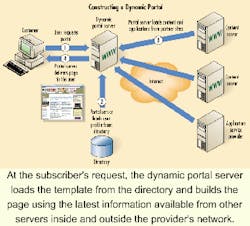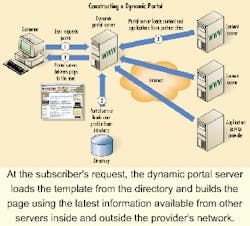Today's network is only as good as the service it provides
Land-rush days are over for building out networks, as providers focus on attracting high-value traffic to their networks.
Dan Hullette
Ellacoya Networks
The optical-network build-out that has taken place over the last few years resembles the 19th century land rush of the American West. Service providers scrambled to extend their physical network presence and attach paying customers to that network. They focused on a core set of basic services, which typically include network access, e-mail, and Web hosting.
Statistics indicate that the latest land rush has slowed recently. Analysts at Sanford C. Bernstein & Co. predict that growth in capital spending by carriers will slow from 28% in 2000 to 20% in 2001.
As the land-rush phase declines, a land-yield phase begins. Once providers have established a physical presence and a customer base, they will focus on attracting the highest-value traffic to their networks. They will augment basic access services with content and applications that could eventually become the primary sources of their revenue. By increasing customer yield, providers can continue to grow revenue even after subscriber growth levels off.
In the land-rush phase, first-mover advantage consisted of being the first provider to deploy a certain generation of optical equipment in the network. The first provider to offer OC-3 (155-Mbit/sec) Internet connections captured all customers who wanted OC-3 connections. In the land-yield phase, the provider must not only achieve, but also sustain, its first-mover advantage.
Being first to market with one high-value service is not enough. The provider must consistently introduce every new service that comes along ahead of the market to keep customers from going elsewhere. In short, the provider needs the ability to roll out new services in a matter of weeks, instead of months or years.
This approach begs the question of what exactly these new application services will be. Unfortunately, there is no crystal ball to help a provider divine the list of broadband applications businesses and consumers will buy in the future. The Internet has all of the mystical potential of the personal computer 15 or 20 years ago. Everyone had the sense that the PC would change the way people lived and worked. Who would have looked at a stack of vinyl record albums sitting next to a 128-kbyte Macintosh in 1984 and thought, "You know, someday I'll be able to use my computer to trade electronic copies of any song I want with people around the world for free."
Broadband establishes the baseline for the evolution of network applications. But providers will have to move quickly in creating new intelligent services for Internet Protocol (IP). If a provider cannot keep up with the pace of innovation, then new customers will choose the more complete offerings available through competitors. Providers relying on traditional means of new service deployment, with one-at-a-time construction, will fall behind despite the heroic efforts of their staff to keep up with needed network, back-office, and operations revisions.
By installing the right infrastructure today, service providers can benefit from these changes, no matter what direction they take. The right infrastructure can adapt easily to new services and change its behavior as users and services change.
Providers do not usually expect their network equipment to adapt to different users or applications (and certainly not to the practically limitless combinations of users and services). But the rise of the Lightweight Directory Access Protocol (LDAP) and commonly available directory servers now makes this capability feasible. The directory can serve as a central point of network intelligence.
If every switch in the network behaves in a manner consistent with the rules set forth in the directory, introducing new services becomes easier by orders of magnitude. To introduce a new service or change an existing service, the provider alters the directory instead of manually changing the configuration of hundreds or thousands of switches. That reduces the burden on the provider's operational staff, to be sure, but it also has far-reaching implications for the types of services the provider can offer.
To win in the land-yield phase, the provider must do three things: capture the customer's full attention, establish a mechanism for integrating partners' services into the network quickly and seamlessly, and keep track of everything and turn those services into revenue.
Most provider Websites offer static information. The site commonly contains some information about the company and the services it offers. Some providers have partnerships with portal wholesalers such as MyWay that bring the capabilities of their sites up to the level of a customizable portal such as Yahoo! or Excite.
At this point, the provider should expect that most users already have a traditional personalized portal. They have configured it with their stock portfolios and the type of news they like to read. They would not switch to another portal that offers the same features, because they would have to re-enter their information and learn to use a new site. To capture the user's attention, the provider must go beyond the capabilities of a typical mass-market portal.
Using directories, the provider can introduce a dynamic portal that will capture the user's attention. A dynamic portal may contain some of the same mass-market information as a traditional portal, but it adds the context that gives the user a much more personalized experience. So in addition to stocks and weather, the dynamic portal can provide access to specialized content and application services. To accomplish customization, the provider deploys a dynamic portal server to aggregate content and applications from both the provider's network and the Internet and presents a personalized view of the information to the end user.
The dynamic portal server depends on a directory that contains an entry for each user (see Figure). The entry includes a template for that user's personal portal page. When the user requests the portal page, the dynamic portal server loads the template from the directory, then builds the page using the latest information available from other servers inside and outside the provider's network. Then the provider delivers the completed page to the user.Once the provider has captured the user's attention, it can market additional content and services to that user. Major Internet service providers earn a fortune on this approach, and with the right infrastructure, a broadband provider can apply the same model to the business and broadband consumer markets. Application services represent the next wave of Internet-based offerings. Some providers may want to become application service providers (ASPs), but most will likely establish partnerships with ASPs. Through the partnerships, the provider can offer application services to its customers without becoming an expert in applications.
This opportunity looks great on paper, so why are so few providers reselling applications today? ASPs certainly recognize the value of gaining access to a provider's subscriber base. Providers see the risk that bandwidth could become a commodity. But the technical challenges of producing an integrated offering have prevented these partnerships so far. Applications such as voice and video services may require traffic prioritization to meet acceptable quality levels. Other applications may need access controls that will limit the service to specific users during a specific time of day or day of the week.
Integrating an application into a dynamic portal offers a starting point for partnering with ASPs, but as the examples here illustrate, it may not be enough. In many cases, the network itself will have to adapt to the new applications. With a directory-based infrastructure, once the provider provisions a new service in the directory and assigns the service to a subscriber, the changes will ripple through the network automatically when the network devices see that user.
Suppose the provider wants to introduce enhanced voice applications in conjunction with a new voice-over-IP service. To make the voice quality equal to or better than a private branch exchange, the provider will want to prioritize voice packets traveling between an IP phone and a gateway to the public telephone network. In a traditional IP environment, this approach would require manual configuration of the switches and routers that might see such traffic. But in a directory-based network, the provider would simply create a new service in the directory and indicate that the service should receive a specific quality-of-service level. When a user requests that service on the network, the switches and routers handling the service will download the service definition from the directory and behave accordingly.
If the provider wants the ability to introduce new services every month, a directory-based network will make it possible. But no network can ensure that the provider will collect the revenue for the service. To close the loop and earn a profit, providers have a choice to make with respect to application services. Should they bill for the applications themselves and remit their wholesale cost to application partners, or should they allow partners to bill the end users and send them a commission?
In general, most providers would probably prefer to bill end users themselves. However, that will not always be the right choice. First, the provider should take an inventory of its back-office systems. Can the current billing system support the new services? Many modern billing packages now support LDAP so that network-service definitions can match product and rate definitions.
Some billing systems even have mechanisms to ensure that the customer database and the users in the directory stay synchronized. That prevents the two most common back-office problems: billing customers for services they don't receive and not billing customers for services they do receive. Providers with these capabilities should plan to bill for applications services directly and send a check to partners every month.
Providers that recently built or bought a billing system without these features will want to let partners handle billing whenever possible. And those that are currently evaluating a new billing system will want to make sure that system supports application services and resale.
Providers who have built broadband optical networks have just reached the starting line, not the finish line. Once a provider has achieved first-mover advantage in access services, it should maintain that advantage by putting in place the infrastructure to introduce a continuous stream of new content and application services based on partnerships.
In the coming land-yield phase of the evolution of the Internet, providers will discover uses for their networks that no one has yet imagined. By making a few preparations today, providers can take advantage of future changes, turning them into opportunities instead of potential threats. Best of all, applications serve as an additional source of revenue, insulating providers from exposure to changes in the market price of access services.
Dan Hullette is a founder and vice president of research and development at Ellacoya Networks (Merrimack, NH).

